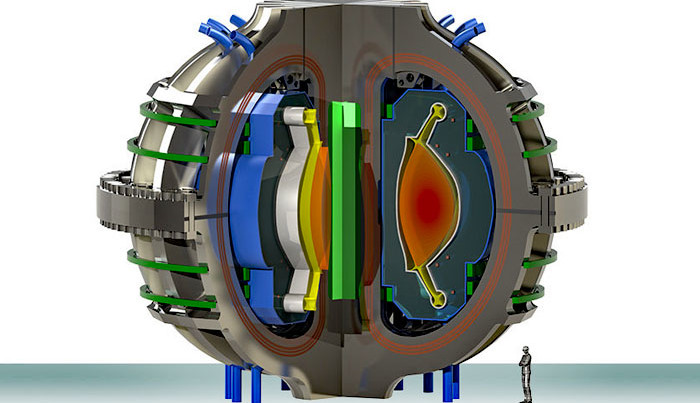Novel Tokamak reactor design
October 18, 2018
on
on

In a brainstorming class-exercise held at MIT together with industry researchers a novel concept to shed unwanted heat produced inside a toroidal Tokamak-style fusion power plant has been formulated.
The new ARC (Advanced, Robust, Compact) solution allows for a more compact fusion reactor design employing electromagnets built using high-temperature superconducting material. The development has led to a new research program at MIT and the founding of a startup company to exploit the concept. Unlike conventional Tokamac construction, the new design allows access to the internal chamber for routine maintenance purposes which gives it an important advantage for economic operation. The new principle is described in a paper in the journal Fusion Engineering and Design.
According to Prof. Whyte (who taught the class at MIT), drawing on an analogy to the exhaust system of an internal combustion engine, the new design allows the reactor’s exhaust pipe to be much wider and longer than can be accommodated in current reactor designs, thereby allowing it to extract much more of the unwanted heat.
Most of the energy generated in a fusion reactor is released in the form of neutrons which heat a ‘blanket’ of material surrounding the fusing plasma. The heat energy in the blanket is then used to drive the generator turbine. About 20 % of the energy is generated in the plasma itself and this needs to be dissipated otherwise its extreme temperature will destroy the chamber. Powerful magnets constrain the plasma to prevent it making contact with the inner walls of the fusion chamber. In conventional fusion reactor design another configuration of magnets is used to produce a side chamber allowing the heat to dissipate but in the new design this method would not be sufficient.
The new design will allow the construction of a much smaller reactor providing comparable performance. In conventional fusion reactors, the secondary coils are built around the outside of the primary coils and need to be powerful. By placing them inside the primary coils they are closer to the plasma and can be made much smaller. Computer simulations have verified the effectiveness of the new design.
The new ARC (Advanced, Robust, Compact) solution allows for a more compact fusion reactor design employing electromagnets built using high-temperature superconducting material. The development has led to a new research program at MIT and the founding of a startup company to exploit the concept. Unlike conventional Tokamac construction, the new design allows access to the internal chamber for routine maintenance purposes which gives it an important advantage for economic operation. The new principle is described in a paper in the journal Fusion Engineering and Design.
According to Prof. Whyte (who taught the class at MIT), drawing on an analogy to the exhaust system of an internal combustion engine, the new design allows the reactor’s exhaust pipe to be much wider and longer than can be accommodated in current reactor designs, thereby allowing it to extract much more of the unwanted heat.
Most of the energy generated in a fusion reactor is released in the form of neutrons which heat a ‘blanket’ of material surrounding the fusing plasma. The heat energy in the blanket is then used to drive the generator turbine. About 20 % of the energy is generated in the plasma itself and this needs to be dissipated otherwise its extreme temperature will destroy the chamber. Powerful magnets constrain the plasma to prevent it making contact with the inner walls of the fusion chamber. In conventional fusion reactor design another configuration of magnets is used to produce a side chamber allowing the heat to dissipate but in the new design this method would not be sufficient.
The new design will allow the construction of a much smaller reactor providing comparable performance. In conventional fusion reactors, the secondary coils are built around the outside of the primary coils and need to be powerful. By placing them inside the primary coils they are closer to the plasma and can be made much smaller. Computer simulations have verified the effectiveness of the new design.
Read full article
Hide full article


Discussion (0 comments)